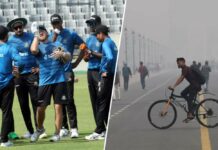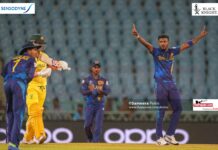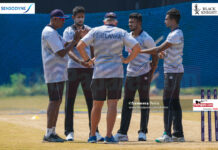On Sunday at the iconic Sydney Cricket Ground, Dinesh Chandimal gave the Australians an almighty scare.
The diminutive middle-order batsman, known to excite and enervate in equal measure, tore into the opposition attack with a 22-ball half-century. Suddenly, the target of 377 didn’t appear as farfetched as it did when the stalwart Kumar Sangakkara fell. Aussie skipper Michel Clarke knew he’d have to reschedule that early massage appointment.
Then something snapped in Chandimal’s right leg. A small tweak of a muscle and he became a shadow of the man he was just minutes before. As the physiotherapist rushed to the Sri Lankan’s aid, the cameras panned to Clarke for a brief second. He knew. He’d been there. It wasn’t a happy place. Couple of deliveries later, a disconsolate Chandimal decided he couldn’t continue anymore and began the long walk back to the pavillion even as the Sri Lankan fans stood to salute their hero. He knew then, as did Clarke surely, that his World Cup was well and truly over.
It has been that kind of a World Cup for Sri Lanka. In fact, Chandimal became the latest subject for Sri Lanka reaching out to ICC’s Technical Committee that oversees and approves squad replacement. Before Chandimal, the Sri Lankan contingent at the World Cup had lost paceman Dhammika Prasad (fractured hand), all-rounder Jeevan Mendis (hamstring) and batsman Dimuth Karunaratne (fractured little-finger) to injuries forcing the sports ministry back home ready backups. Ace spinner Rangana Herath injured his finger while attempting a return catch against England ruling him out of the Australia clash in Sydney where Chandimal joined the treatment table. Immediate reactions to incidents such as these generally focus on its implication to the team’s fortunes in the remainder of the tournament. The fate of the player and his future merits little to no discussion.
For long, sporting injuries have been looked upon as unfortunate yet unavoidable occupational hazards. With the advent of modern medicine and improvements in overall athlete fitness levels, the average career span of a sportsman is roughly estimated to be around 10-12 years. Factor in the level of competition and this number varies up or down by 2 years. This also includes a maximum of 5 to 6 years of peak performance.The World Cup rolls around once every four years.
If these statistics are to be trusted, it is quite possible that the average player gets just about two real cracks at World Cup glory. At optimum physical condition that is. Then there’s the small matter of actually making the side in those years and eventually putting in the required on-field performances. How much of becoming a World Champion is about luck and how much is it down to keeping oneself in pristine condition in the right time? One may never know. For some of the world’s truly great athletes have fallen by the wayside due to factors outside their control.
In 2006, Theo Walcott, the Arsenal winger, was surprisingly named in England’s squad for the Football World Cup by coach Sven-Goran Eriksson. Walcott, then 17, had made only 13 appearances in senior football and none in the English Premier League. With senior strikers like Michael Owen and Wayne Rooney heading the line for the the Three Lions, Walcott’s contribution in Germany was largely restricted to warming the bench. Four years on, a 21-year old Walcott had emerged as a regular in Arsene Wenger’s Arsenal side and was tipped as being among the leading young players in England. The new England coach Fabio Capello saw otherwise and left him out of his squad that crashed out against Germany in the pre-quarterfinals. Walcott’s exclusion drew surprise from even Lionel Messi before Capello accepted that he might have erred in his selection. At 25, the 2014 World cup in Brazil should have seen Walcott at his optimum fitness. As fate would have it, he ruptured an anterior cruciate ligament in his left knee while playing for his club and was ruled out of the mega event. If Walcott were to reflect on his career now, he’d see a grossly unflattering story. However, it could have so easily been very different.
Who is to say Chandimal or Walcott won’t feature in the next World Cup? Sport is, after all, known for its glorious uncertainties. However, new talent and newer injuries on an aching body make it that much harder to keep the motivation going. The legendary Waqar Younis, who featured in three Cricket World Cups for Pakistan between 1996 and 2003, for all his achievements in cricket, never earned the ‘World Champion’ tag. He missed Pakistan’s victorious 1992 campaign with an injury sustained one week before the start of the event. Waqar, as he said often, will cherish the moment when Imran Khan’s ‘Tigers’ arrived in Lahore with the trophy but the fact that he wasn’t part of that campaign will certainly prick him as travels across Australia and New Zealand as coach of the Pakistan side, looking to give himself, as much as Pakistan, a World Cup victory.
Even as Chadimal stroked his way to what was then the fastest fifty by a Sri Lankan in World Cups, he knew that his fledgling international career had already experienced more than its fair share of ups and down. He’d gone from being earmarked as Sri Lanka’s next great batting hope to losing form, confidence and his place in the side. He went from being named the captain of his country for a World Cup (2014 World T20 in Bangladesh) only to be asked to step aside midway through the event and hand over the reigns to Lasith Malinga and made to watch from the sidelines as his side captured their first major title after 18 long years. And now as Sri Lanka embark on the final stretch of their mission of giving veterans Sangakkara and Mahela Jayawardene a fitting farewell, Chandimal won’t be required. As Dinesh Chandimal endured the excruciatingly painful walk back to the dressing room, one was left to wonder – What hurt more?















